| Version 40 (modified by , 18 years ago) (diff) |
|---|
Writing efficient TLM-T SystemC simulation models for SoCLib
Authors : Alain Greiner, François Pêcheux, Emmanuel Viaud, Nicolas Pouillon
A) Introduction
This document describes the modeling rules for writing TLM-T SystemC simulation models for SoCLib. These rules enforce the PDES (Parallel Discrete Event Simulation) principles. Each PDES process involved in the simulation has its own local time, and PDES processes synchronize through messages piggybacked with time information. The process time, as well as other useful process attributes, is contained in a C++ structure called a thread context. Models complying to these rules can be used with the "standard" OSCI simulation engine (SystemC 2.x), but can also be used also with others simulation engines, especially distributed, parallelized simulation engines.
The interested user should also look at the general SoCLib rules.
B) Single VCI initiator and single VCI target
Figure 1 presents a minimal system containing one single initiator, my_initiatorVciSimpleInitiator , and one single target, my_targetVciSimpleTarget . The my_initiatorVciSimpleInitiator module behavior is modeled by the SC_THREAD execLoop(), that contains an infinite loop. The call-back function rspReceived() is executed when a VCI response packet is received by the initiator module.
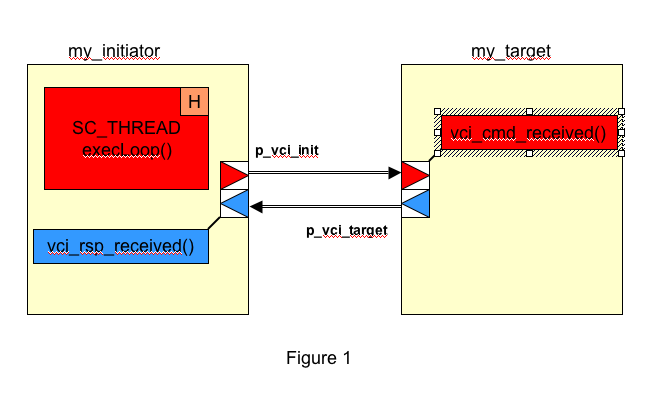
Unlike the initiator, the target module has a purely reactive behaviour and is therefore modeled as a call-back function. Actually, there is no need to use a SC_THREAD : The target behaviour is entirely described by the call-back function cmdReceived(), that is executed when a VCI command packet is received by the target module.
The VCI communication channel is a point-to-point bi-directionnal channel, encapsulating two separated uni-directionnal channels : one to transmit the VCI command packet, one to transmit the VCI response packet.
C) VCI initiator Modeling
In the proposed example, the initiator module is modeled by the my_initiator class. This class inherits from the BaseModule class, that acts as the root class for all TLM-T modules. As there is only one thread in this module, there is only one member variable m_time of type tlmt_time, corresponding to the PDES process local time (H on the figure). This m_time object can be accessed through the getTime(), addTime() and setTime() methods.
The execLoop() method, describing the initiator activity must be declared as a member function of the my_initiator class.
Finally, the class my_initiator must contain a member variable p_vci, of type VciInitiatorPort. This object has a template parameter <vci_param> defining the widths of the VCI ADRESS & DATA fields.
C.1) Sending a VCI command packet
To send a VCI command packet, the execLoop() method must use the send() method, that is a member function of the p_vci port. The prototype is the following:
void send(vci_cmd_t *cmd, // VCI command packet
uint32_t time); // initiator local time
The informations transported by a VCI command packet are defined below:
class vci_cmd_t {
vci_param::vci_command_t cmd; // VCI transaction type
vci_param::vci_address_t *address; // pointer to an array of addresses on the target side
uint32_t be; // byte_enable value (same value for all packet words)
bool contig; // contiguous addresses (when true)
vci_param::vci_data_t *buf; // pointer to the local buffer on the initiator
uint32_t length; // number of words in the packet
uint32_t srcid; // VCI Source ID
uint32_t trdid; // VCI Thread ID
uint32_t pktid; // VCI Packet ID
}
The possible values for the cmd fied are vci_param::CMD_READ, vci_param::CMD_WRITE, vci_param::CMD_READ_LOCKED,
and vci_param::CMD_STORE_COND.
The contig field can be used for optimisation.
The send() function is non-blocking. To implement a blocking transaction (such as a cache line read, where the processor is frozen during the VCI transaction), the model designer must use the wait() primitive : the execLoop() thread is suspended, and will be activated when the response packet is received.
C.2) Receiving a VCI response packet
To receive a VCI response packet, a call-back function must be defined as a member function of the class my_initiator. This call-back function (named rspReceived() in the example), will be executed each time a VCI response packet is received on the p_vci port. The function name is not constrained, but the arguments must respect the following prototype:
void rspReceived(vci_rsp_t *rsp, uint32_t time)
The informations transported by a VCI response packet are defined below:
class vci_rsp_t {
vci_command_t cmd; // VCI transaction type
uint32_t length; // number of words in the packet
uint32_t error; // error code (0 if no error)
uint32_t srcid; // VCI Source ID
uint32_t trdid; // VCI Thread ID
uint32_t pktid; // VCI Packet ID
}
The actions executed by the call-back function depend on the transaction type (cmd field), as well as the pktid and trdid fields.
In the proposed example :
- In case of of a blocking read , the call-back function updates the local time, and activates the suspended thread.
- In case of a non-blocking write, the call-back function does nothing.
C.3) Initiator Constructor
The constructor of the class my_initiator must initialize all the member variables, including the p_vci port. The rspReceived() call-back function being executed in the context of the thread sending the response packet, a link between the p_vci port and the call-back function must be established. Moreover, the p_vci port must contain a pointer to the initiator local time.
The VciInitiatorPort constructor must be called with the following arguments:
p_vci(“vci”, this, &my_initiator::rspReceived, &m_time);
C.4) Lookahead parameter
The SystemC simulation engine behaves as a cooperative, non-preemptive multi-tasks system. Any thread in the system must stop execution after at some point, in order to allow the other threads to execute. With the proposed approach, a TLM-T initiator will never stop if it does not execute blocking communication (such as a processor that has all code and data in the L1 caches).
To solve this problem, it is necessary to define - for each initiator module- a lookahead parameter. This parameter defines the maximum number of cycles that can be executed by the thread before it stops. The lookahead parameter allows the system designer to bound the de-synchronization between threads.
A small value for this parameter result in a better timing accuracy for the simulation, but implies a larger number of context switch, and a slower simulation speed.
C.4) VCI initiator example
template <typename vci_param>
class my_initiator : tlmt::BaseModule {
public:
VciInitiatorPort <vci_param> p_vci;
//////// constructor
my_initiator (sc_module_name name,
uint32_t initiatorIndex
uint32_t lookahead) :
p_vci(“vci”, this, &my_initiator::rspReceived, &m_time),
tlmt::BaseModule(name),
m_time(0)
{
m_index = InitiatorIndex;
m_lookahed = lookahead;
m_counter = 0;
SC_THREAD(execLoop);
} // end constructor
private:
tlmt_time m_time; // local clock
uint32_t m_index; // initiator index
uint32_t m_counter; // iteration counter
uint32_t m_lookahed; // lookahead value
vci_param::data_t m_data[8]; // local buffer
vci_cmd_t m_cmd; // paquet VCI commande
sc_event m_rsp_received; // synchronisation signal
//////// thread
void execLoop()
{
while(1) {
…
m_cmd.cmd = VCI_CMD_READ;
p_vci.send(&m_cmd, m_time.getTime()); // lecture bloquante
wait(m_rsp_resceived);
…
m_cmd.cmd = VCI_CMD_WRITE;
p_vci.send(&m_cmd, m_time.getTime()); // écriture non bloquante
...
// lookahead management
m_counter++ ;
if (m_counter >= m_lookahead) {
m_counter = 0 ;
wait(SC_ZERO_TIME) ;
} // end if
m_time.addtime(1) ;
} // end while
} // end execLoop()
//////////////// call-back function
void rspReceived(vci_cmd_t *cmd, uint32_t rsp_time)
{
if(cmd == VCI_CMD_READ) {
m_time.set_time(rsp_time + length);
m_rsp_received.notify(SC_ZERO_TIME) ;
}
} // end rspReceived()
} // end class my_initiator
D) VCI target modeling
In the proposed example, the target handle two types of command : a read burst of 8 words, and a write burst of 8 words. To simplify the model, there is no error management.
The class my_target inherit the class BaseModule, that is the basis for all TLM-T modules. The class my_target contains a member variable p_vci of type VciTargetPort. This object has a template parameter <vci_param> defining the widths of the VCI ADRESS & DATA fields.
D.1) Receiving a VCI command packet
To receive a VCI command packet, a call-back function must be defined as a member function of the class my_target. This call-back function (named cmdReceived() in the example), will be executed each time a VCI command packet is received on the p_vci port. The function name is not constrained, but the arguments must respect the following prototype:
uint32_t cmdReceived(vci_cmd_t *cmd,
uint32_t time)
For the read and write transactions, the actual data transfer is performed by this cmdReceived() function. To avoid multiple data copies, only the pointer on the initiator data buffer is transported in the VCI command pacquet (source buffer for a write transaction, or destination buffer for a read transaction).
D.2) Sending a VCI response packet
To send a VCI response packet the cmdReceived() function must use the send() method, that is a member function of the class VciTargetPort, and has the following prototype:
void send( vci_rsp_t *cmd,
uint32_t time)
For a reactive target, the response packet date is computed as the command packet date plus the target intrinsic latency.
D.3) Target Constructor
The constructor of the class my_target must initialize all the member variables, including the p_vci port. The cmdReceived() call-back function being executed in the context of the thread sending the command packet, a link between the p_vci port and the call-back function must be established. The VciTargetPort constructor must be called with the following arguments:
p_vci(“vci”, this, &my_initiator::cmdReceived)
D.4) VCI target example
template <typename vci_param>
class my_target : tlmt::BaseModule {
public:
VciTargetPort<vci_param> p_vci;
////////////// constructor
my_target (sc_module_name name,
uint32_t targetIndex,
uint32_t latency):
p_vci(“vci”,this, &my_target::cmdReceived),
tlmt::BaseModule(name)
{
m_latency = latency;
m_index = targetIndex;
} // end constructor
private:
vci_param::data_t m_data[8]; // local buffer
uint32_t m_latency; // target latency
uint32_t m_index; // target index
vci_rsp_t m_rsp; // paquet VCI réponse
/////////////// call-back function
uint32_t cmdReceived(vci_cmd_t *cmd,
uint32_t cmd_time)
{
if(cmd->cmd == VCI_CMD_WRITE) {
for(int i = 0 ; i < length ; i++) m_data[i] = cmd->buf[i];
}
if(cmd->cmd == VCI_CMD_READ) {
for(int i = 0 ; i < length ; i++) cmd->buf[i] = m_data[i];
}
m_rsp.srcid = cmd->srcid;
m_rsp.trdid = cmd->trdid;
m_rsp.pktid = cmd>pktid;
m_rsp.length = cmd->length;
m_rsp.error = 0;
rsp_time = cmd_time + latency;
p_vci.send(&m_rsp, rsp_time) ;
return (rsp_time + cmd->length);
} // end cmdReceived()
} // end class my_target
E) VCI Interconnect
The VCI interconnect used for the TLM-T simulation is a generic simulation model, named VciVgmn. The two main parameters are the number of initiators, and the number of targets. In TLM-T simulation, we don't want to reproduce the cycle-accurate behavior of a particular interconnect. We only want to simulate the contention in the network, when several VCI intitiators try to reach the same VCI target. Therefore, the network is actually modeled as a complete cross-bar : In a physical network such as the multi-stage network described in Figure 2.a, conflicts can appear at any intermediate switch. In the VciVgmn network described in Figure 2.b, conflicts can only happen at the output ports. It is possible to specify a specific latency for each input/output couple. As in most physical interconnects, the general arbitration policy is round-robin.
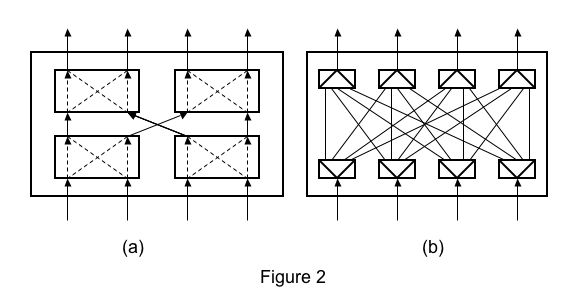
E.1) Generic network modeling
There is actually two fully independent networks for VCI command packets and VCI response packets. There is a routing function for each input port, and an arbitration function for each output port, but the two networks are not symmetrical :
- For the command network, the arbitration policy is distributed: there is one arbitration thread for each output port (i.e. one arbitration thread for each VCI target). Each arbitration thread is modeled by a SC_THREAD, and contain a local clock.
- For the response network, there is no conflicts, and there is no need for arbitration. Therefore, there is no thread (and no local time) and the response network is implemented by simple function calls.
This is illustrated in Figure 3 for a network with 2 initiators and three targets :
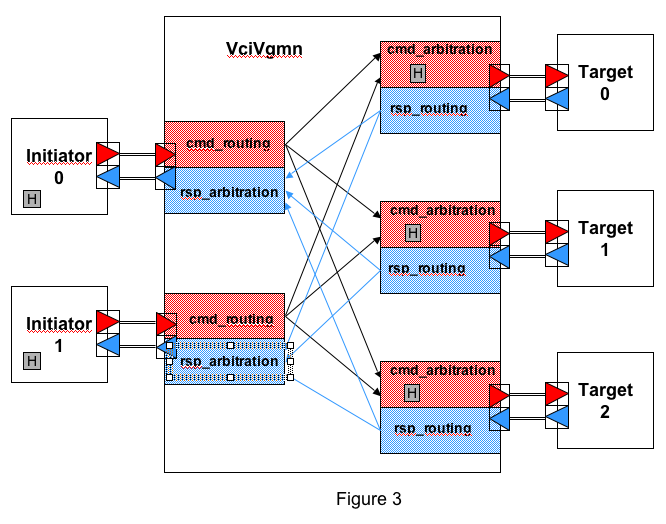
E.2) VCI initiators and targets synchronisations
As described in sections B & C, each VCI initiator TLM-T module contains a thread and a local clock. But, in order to increase the TLM-T simulation speed, the VCI targets are generally described by reactive call-back functions. Therefore, there is no thread, and no local clock in the TLM-T module describing a VCI target. For a VCI target, the local clock is actually the clock associated to the corresponding arbitration thread contained in the VciVgmn module.
As described in Figure 4, when a VCI command packet - sent by the corresponding arbitration thread - is received by a VCI target, two synchronization mechanisms are activated :
- The cmdReceived() function sends a VCI response packet with a date to the source initiator, through the VciVgmn response network. The corresponding date can be used to update the initiator local clock.
- The cmdReceived() function returns a date to the arbitration thread. This date is used to update the arbitration thread local clock.
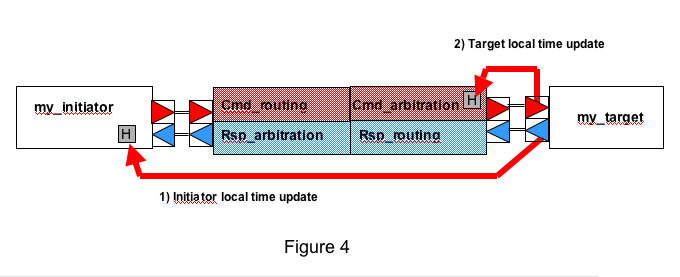
F) Interrupt modeling
Interrupts are asynchronous events that are not transported by the VCI network.
As illustrated in Figure 5, each interrupt line is modeled by a specific point to point, uni-directional channel. It use two ports of type SynchroOutPort and SynchroInPort that must be declared as member variables of the source and destination modules respectively.
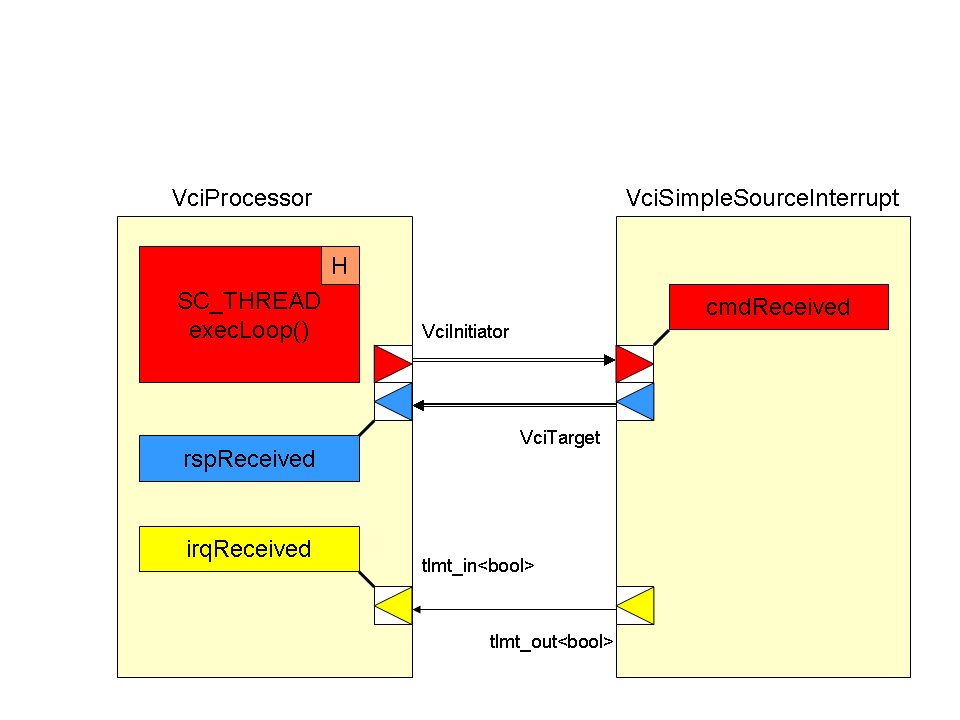
F.1) Source modeling
The source module (named my_source in this example) must contain a member variable p_irq of type SynchroOutPort. To activate, or desactivate an interruption, the source module must use the send() method, that is a member function of the SynchroOutPort class. Those interrupt packets transport both a Boolean, and a date. The send() prototype is defined as follows :
void send( bool val, uint32_t time)
F.2) Destination modeling
The destination module (named here my_processor) must contain a member variable p_irq of type SynchroInPortt, and a call-back function (named here irqReceived() that is executed when an interrupt packet is received on the p_irq port.
A link between the p_irq port and the call-back function mus be established by the port constructor in the constructor of the class my_processor :
p_irq(“irq”, this, &my_processor::irqReceived)
In the Parallel Discrete Event Simulation, the pessimistic approach suppose that any PDES process is not allowed to update his local time until he has received messages on all input ports with dates larger than his local time.
Therefore, a SC_THREAD modeling the behavior of a processor containing an SynchroInPort should in principle wait a dated packet on this interrupt port before executing instructions. Such behavior would be very inefficient, and could create dead-lock situations.
The recommended policy for handling interrupts is the following:
- The call-back function irqReceived() sets the member variables m_irqpending and m_irqtime, when a interrupt packet is received on the p_irq port.
- The execLoop() thread must test the m_irqpending variable at each cycle (i.e. in each iteration of the infinite loop).
- If there is no interrupt pending, the thread continues execution. If an interrupt is pending, and the interrupt date is larger than the local time, the thread continues execution. If the interrupt date is equal or smaller than the local time, the interrupt is handled.
Such violation of the the pessimistic parallel simulation create a loss of accuracy on the interrupt handling date. This inaccuracy in the TLM-T simulation is acceptable, as interrupts are asynchronous events, and the timing error is bounded by the m_lookahead parameter.
F.3) Processor with interrupt example
class my_processor : tlmt::BaseModule {
public:
SynchroInPort p_irq;
////// constructor
my_processor (sc_module_name name,
uint32_t lookahead) :
p_irq(“irq”, this, &my_initiator::irqReceived),
m_time(0),
tlmt::BaseModule(name)
{
m_lookahed = lookahead;
m_counter = 0;
m_irqset = false;
SC_THREAD(execLoop);
} // end constructor
private:
tlmt_time m_time; // local clock
bool m_irqpendig; // pending interrupt request
uint32_t m_irqtime; // irq date
uint32_t m_counter; // iteration counter
uint32_t m_lookahed; // lookahead value
/////////////// thread
void execLoop()
{
while(1) {
...
// test interrupts
if (m_irqpending && (m_irqtime <= m_time.getTime())) {
// traitement interrupt
}
...
// lookahead management
m_counter++ ;
if (m_counter >= m_lookahead) {
m_counter = 0 ;
wait(SC_ZERO_TIME) ;
} // end if
m_time.addtime(1) ;
} // end while
} // end execLoop()
///////////////////////////////////////
void irqReceived(bool val, sc_time time)
{
m_irqpending = val;
m_irqtime = time;
} // end irqReceived()
} // end class my_processor
Attachments (7)
- tlmt_figure_2.png (17.3 KB) - added by 18 years ago.
- tlmt_figure_4.png (21.5 KB) - added by 18 years ago.
- tlmt_figure_3.png (59.0 KB) - added by 18 years ago.
- tlmt_figure_5.png (7.2 KB) - added by 18 years ago.
- tlmt_figure_1.png (18.7 KB) - added by 17 years ago.
- tlmt_vgmn.png (33.3 KB) - added by 17 years ago.
- tlmt_initiator_target.png (10.2 KB) - added by 17 years ago.
Download all attachments as: .zip

